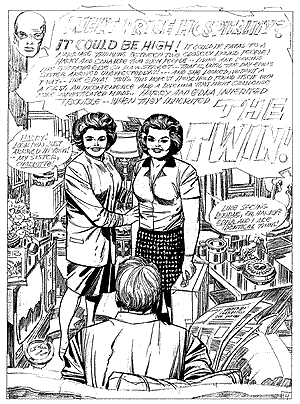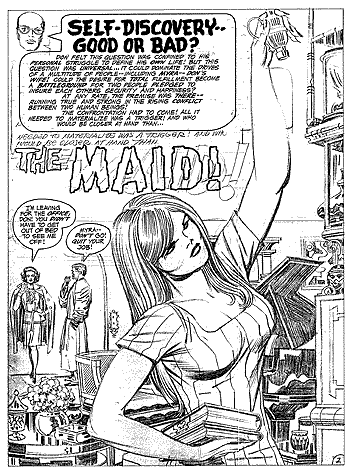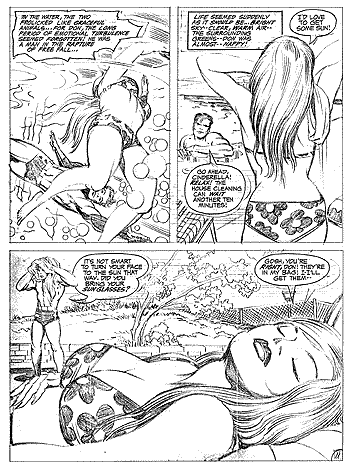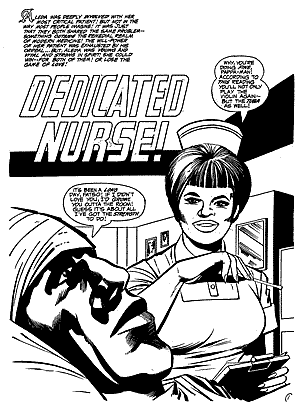Heart and Soul:
True Divorce Cases and Soul Love
examined by and © John Morrow
From Jack
Kirby Collector #23

Jack's splash page to "The Twin" from the unpublished True Divorce
Cases #1
- partially inked by Vincent Colletta.
© DC Comics, Inc.
Kirby's early days at National Periodicals in the 1970s must've seemed to him
like a time of infinite possibilities. After a period of strained relations
with the Marvel "House of Ideas" he helped build, his new contract
at DC was a chance to start fresh and try a plethora of new, daring ideas he's
not wanted to relinquish to the Marvel mill. But throughout Jack's five years
at DC, his work continually hearkened back to all the big hits he had with Joe
Simon in the '40s and '50s. Look at the list of rehashes: The Guardian and the
Newsboy Legion (in Jimmy Olsen); Sandman (in his own book, where Jack even reteamed
with Joe Simon one last time); Manhunter (a one-shot in First Issue Special);
the Losers (an attempt to play off the wartime success of Boy Commandos?); the
Demon (shades of Black Magic!); and the Dingbats of Danger Street (another go
at the venerable "Kid Gang" concept). DC even tried reprints of such
S&K classics as Black Magic and Boy Commandos. Apparently publisher Carmine
Infantino felt that after acquiring Marvel's creative powerhouse, the best route
to take would be to send him down the paths (and genres) that had sold millions
of Simon & Kirby comics in the past. It's a credible strategy from a publishing
standpoint-building off of past successes-but there's one thing that apparently
wasn't considered: Jack's constant desire to create "the next big thing"
in comics. He would never be content to simply look to his past glories, and
to his credit he always attempted to bring something new to these tried-and-true
concepts.
Still, in the early days Kirby was allowed some conceptual freedom. The groundbreaking
Fourth World took the super-hero genre to new heights, and several magazine
concepts were devised, with at least a full issue drawn of four of them (although
only In The Days of the Mob and Spirit World were ever published, albeit in
a format different than what Jack originally envisioned)-and while these magazines
were also rooted in the best-selling Simon & Kirby genres (crime, horror,
and romance), the end result was unlike anything the S&K team had ever produced,
particularly in the romance vein.
Breaking Up Is Hard To Do
For Jack's first try, he created what's been dubbed the first anti-romance
comic. True Divorce Cases (or True Life Divorce, as it was also known from time
to time during its inception) was-like In The Days of the Mob and Spirit World-Kirby's
attempt at upscale, adult-oriented magazine fare. While divorce had always been
a taboo subject, the "free love" mindset of the 1960s led to a surging
divorce rate in America by 1970, and Jack looked to take advantage of this growing
social trend.
While the concept may seem odd by today's standards, this was cutting edge
for 1970. Jack intended this to be for adults (assistant Steve Sherman even
remembers a rather risqué photo shoot involving a woman in leopard-skin
underwear, a bed, and a motorcycle; this would've been used either on the cover
or as part of a photo story inside the magazine). Perhaps it was a little too
hard-hitting, for after Jack's penciled pages for the entire book were handed
in, the idea was shelved.
A trip to the 1998 Comic-Con International in San Diego gave me a firsthand
look at most of the original art from the book. In our Twentieth
Issue we offered a glimpse at the three-page story "The Cheater"
that would've ended the mag, and the remarkable "The Other Woman",
a ten-page tale with an unexpected ending. Also done for the issue was the thirteen-page
"The Maid", a story of the conflicts that can arise when a liberated
woman enters the workforce, and leaves the housework (and unknowingly, her husband's
emotional upkeep) to a beautiful young maid. (Here's another then-current trend
Jack was exploiting to good effect: The Woman's Liberation movement that caused
such upheaval in the late 1960s-early 1970s.) Next up was "The Twin,"
a seven-pager dealing with the trials and temptations of having an exact double
(or in this case, a more outgoing, sexually-charged version) of your wife in
the house. (Although almost the entire issue has been lettered, only the first
two pages of "The Twin" have been partially inked by Vince Colletta;
the rest of the book remains in pencil form.)
Upon reading these stories, I discovered a remarkably mature Kirby telling
tales of love gone wrong and relationships ending. (Or do they? There were surprise
twists throughout.) Marriage Counselor Geoffrey Miller was the narrator of the
tales, offering snippets of advice at the end of each case.

Jack's splash page to "The Maid" from the unpublished True Divorce
Cases #1.
© DC Comics, Inc.
Of the four stories I've read, there's not a dud in the bunch. The same goes
for the female leads of each; these pages ooze sensuality, and the women depicted
are-to this writer's mind-the sexiest of Jack's career. From the striking good
looks of ingénue Ingrid and the mature beauty of Myra in "The Maid",
to the buxom playfulness of sisters Edna and Charlotte in "The Twin",
Jack captured the feminine form in all its wonderful variety. (Three other examples-the
WASP-ish Janet in "The Cheater" and the catlike Jessica and matronly
Evelyn in "The Other Woman"-were shown in our Twentieth
Issue, as well as an intriguing "next issue" illo showing four
more varied Kirby women.) The entire issue is a gripping read, filled with art
by Jack at his peak, and stories-while plagued with occasionally awkward Kirby
dialogue-that are well-plotted, clever, and genuinely engaging. In the best
tradition of his 1950s romance work, Jack managed to pack more punch into a
bunch of "hearts and flowers" tales than most artists can put into
super-hero yarns.

Pencils from "The Maid" in True Divorce Cases #1, featuring some of Kirby's
most sensuous work. Characters ™ & © DC Comics, Inc. Art ©
Jack Kirby.
Nevertheless, True Divorce Cases was rejected, and remains mostly unpublished
to this day. But since we know Jack averaged 42 pages of story in both issues
of In The Days Of The Mob and Spirit World-and we've only accounted for 33 pages
of True Divorce Cases-it appears there is one 8-10 page story still unaccounted
for. It is this missing story, it seems, that was the genesis of another potentially
groundbreaking concept that (mercifully?) never made it to newsstands.
A Little Bit Of Soul
As reported in our Seventeenth Issue, Kirby had done
one of the divorce-themed stories about an African-American couple, apparently
hoping to appeal to a Black audience just beginning to exercise its consumer
power following the Civil Rights Movement of the 1960s. (Since none of the known
stories from True Divorce Cases is about a Black couple, this must be the missing
story; if you've ever come across an unpublished Kirby story where a Black couple
is on the verge of divorce, let us know.) The decision was made to form an entirely
different magazine around this story, and call it Soul Love (sometimes also
called Soul Romances). The move was no doubt inspired by the blaxploitation
films that gained such popularity in the 1970s, as typified by Blackula, Shaft,
Superfly, and the short-lived TV ladycop show, Get Christy Love.
Whereas True Divorce Cases ranks in my mind as some of Kirby's finest, most
sensitive work, Soul Love leaves much to be desired. As you'll see in the accompanying
10-page story "The Teacher", the characterizations-despite being complemented
by some decent art-just don't ring true. Reading these stories, I get the same
sort of feeling I had watching such 1970s TV fare as Good Times, That's My Mama,
and What's Happening; while moderately entertaining, these characters don't
come anywhere close to resembling real-life African-Americans (or at least my
admittedly Caucasian-skewed interpretation of them, based on experiences growing
up in a very desegregated Southern public school system). There's an effort
made to capture the clothing, hairstyles, and settings of the 1970s Black lifestyle
(and Jack succeeds admirably, probably due to the issues of Ebony assistants
Evanier and Sherman got him for reference), but the stories just fall flat.
In addition to "The Teacher", I had the opportunity to read "Diary
of the Disappointed Doll", a five-pager about a computer dating mix-up
(the splash page was shown in our Seventeenth Issue);
"Dedicated Nurse", a seven-page melodrama about an overweight nurse
who cares for an ailing father, while struggling with her love for his son;
"Fears of a Go-Go Girl", where a dancer named Buffy discovers her
frightening neighbor may not be so strange after all (this one is ten pages
long); and "Old Fires", a two-pager (shown in the Kirby Masterworks
portfolio) about a couple whose love wouldn't die. (Again, this only adds up
to 34 pages, so there appears to be one story missing-probably the one that
started this whole mess in the first place!)
Lacking a narrator (a device that at least gave Jack's other "adult"
publications a personality), Soul Love's stories are generically introduced
with an attempt at "hip" dialect that comes across as horribly forced;
and while the underlying, universal message of love in these romance tales should
theoretically transcend all racial boundaries, Kirby just didn't seem to have
enough "soul" to pull them off convincingly. As True Divorce epitomizes
Jack's finest work, Soul Love just draws more attention to his stilted dialogue,
and stands as some of his worst.
Which is not to say Soul Love is totally without merit. First, Kirby (a then
53-year-old man, with apparently little exposure to Black culture) deserves
credit for even attempting something this radical, and the art is pretty solid
(Vinnie Colletta's inks add a nice softness here). Another extremely positive
note is the unexplained use of Tony DeZuniga as inker on "Diary of the
Disappointed Doll" (as identified by Richard Howell; Colletta fully inked
all the other Soul Love stories). I've no idea why this one was inked by DeZuniga,
but the unusual combination yielded spectacular results. (Of note is the use
of a pasted-up title on the splash page of "Disappointed Doll"; it's
possible this story was originally called "The Model", as mentioned
on Soul Love #1's cover. However, "The Model" could be that missing
story, especially since it's listed first on the cover.)

Jack's splash page to "Dedicated Nurse" from the unpublished Soul
Love #1
- inked by Vincent Colletta.
© DC Comics, Inc.
As mentioned back in our Seventeenth Issue, the faces
of most of the major characters have been redrawn, presumably to make them look
either more or less "Black." There are blue pencil lines and Wite-Out
all over these pages-particularly on character's noses and lips-leading me to
believe that DC fully intended to publish this thing until the last minute.
Still, I can't imagine 1970s readers-regardless of race-really enjoying Soul
Love. While Jack's basic plots are fine, their execution is severely hampered
by dialogue that rivals his worst on Captain Victory for obliqueness.
The difference between the two books is that with True Divorce, the main focus
was something Kirby could relate to: Relationships between two human beings.
But with Soul Love, the importance of the romance is deflected by the superimposed
constraint of making it all look "Black." Here, Jack was working too
hard to convince us that these characters and settings are genuine, and we lose
sight of the skilled storyteller behind them. Had the main characters not been
Black (and the need for Jack's awkward attempt at "cool" lingo eliminated),
this could've made a decent romance comic (although none of these stories have
the clever twists and turns that make True Divorce Cases so special).
I'll bet when that missing story turns up, we'll find the characters' race
to be inconsequential; it'll just be another outstanding romance story. But
for sheer kitsch-appeal, Soul Love-along with the inspired stories from True
Divorce-deserves to be published in one large volume. We'll keep trying to convince
DC to give it a shot (or to let us do it), but in the meantime, enjoy this rare
look at a-perhaps deservedly-forgotten piece of Jack's career.

Sign up here to receive periodic updates about what's going on in
the world of TwoMorrows Publishing.

Click here to download
our new Fall-Winter catalog (2mb PDF file)
|